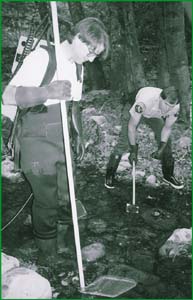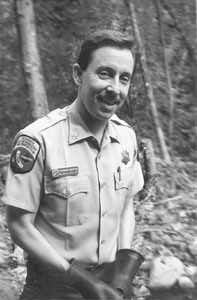At Loggerheads
The Soquel Demonstration Forest shows why local citizens and California forestry officials are not knocking on wood together
By Katherine Knight
THE SOQUEL DEMONSTRATION State Forest is a magical place, as forests tend to be, with deer and songbirds, colorful woodpeckers, bobcats and mountain lions, red-legged frogs and steelhead trout that bask in the creek that runs though it. There are still a few stands of old-growth redwoods tucked among the second-generation trees.
Archaeological evidence suggests prehistoric natives practiced female fertility rites in this forest. It's the headwaters of Soquel Creek, the site of the 1989 earthquake and, over the years, of serious landslides that have contributed to devastating floods in Soquel.
The demo forest also has been a place where, for more than 25 years, citizens have fought for local control over logging operations--and won. But today, only a decade after headlines proclaimed preservation of the 2,681-acre forest, battle lines are again being drawn and lawsuits stand ready to prevent what locals fear will be excessive and damaging logging of the area by the California Department of Forestry and Fire Protection.
The crux of the issue is the forestry department's proposed General Management Plan, which will be voted upon Thursday (Dec. 12) by the demo forest advisory council. The plan calls for logging operations throughout the forest (except four designated old-growth stands) and that would increase annual logging over the next 50 years to 5060 percent of new growth--3 million board feet harvested every two years.
"This is clearly not the intent of the legislation that established the Soquel Demonstration State Forest," states newly elected Assemblymember Fred Keeley, who, as a staff person for then-Assemblymember Sam Farr, worked on the enabling AB 1965 in 1987. "The intent was to preserve and conserve the forest. The legislation authorized 'a limited amount' of timber harvest operations to cover 'maintenance and operation' expenses. It was never meant to be a commercial logging operation."
Thick and Thinning
ALTHOUGH THE LONG-TERM harvest rates are the "maximum sustained production" level--demo forest manager Thom Sutfin disagrees: "The proposed levels are well below those of a commercial harvest, which allow 100 percent of new growth to be cut," he says. "Our goal is to demonstrate how good forest management [AB 1965 does state that the forest will be 'intensely managed'] can improve the watershed and the forest."
Improve the forest? Sutfin maintains state forestry "will produce a biologically diverse, multi-aged forest. Thinning out densely growing trees and removing competition will cause the redwood trees to grow faster. Good forest management, not revenue, is the goal of this plan," he says.
This demonstrates one of the fundamental disagreements between community members and the state: "Should not some areas 'escape' harvest to be compared with logged areas to see how natural systems work?" suggests Don Alley, certified fisheries scientist, writing in the Sierra Club's newsletter, Ventana (February 1993).
Betsy Herbert of Citizens for Responsible Forest Management laments that the foresters have not designated a "no cut/no entry" zone near streams. "Ninety percent of all the wildlife in the forest lives in these riparian corridors. The federal government adopted, in numerous areas, a 300-foot buffer to protect watersheds from damage. The state should do the same."
Local residents are also concerned that logging will happen even on geologically unstable terrain such as the Amaya Creek basin, where landslides have already occurred. "There are areas in this forest that are unbelievably steep," Herbert notes.
Lalo Fiorelli, a neighbor of the Soquel demo forest and a representative of the Amaya Ridge Road Neighborhood Association, is confident, however, that Sutfin and company can pull off a timber harvest without harm, even in the most sensitive areas. "It's one of the things the demo forest is supposed to demonstrate".
Branches and Stunts
IF ANYONE CAN BRIDGE the abyss between the state Department of Forestry and the locals, it's Thom Sutfin. He's a member of the Sierra Club and an avowed environmentalist. He walks lightly in the forest, reverent of every songbird, every squirrel. Sutfin admits that "for most people, good logging is an oxymoron--people mistrust government." In his eyes, he's worked hard to extend the olive branch.
Herbert challenges that, admitting Sutfin's mantra is "achieving acceptance and building consensus," but she adds that he actually "works hard to put a happy face on business-as-usual logging".
In August of 1995, forest managers carried out a small timber harvest and invited the public. More than 300 people viewed the logging--and they approved. "What happened out there was fabulous," Fiorelli comments.
"That first harvest was small, carried out on a geologically stable portion of the property--away from watercourses and with a low slope." notes Mark Morganthaler of Citizens for Responsible Forest Management. "We view it as a public relations stunt by the state."
The 550,000-board-foot harvest yielded $90,000. The Soquel demo forest--which employs two foresters, a seasonal aide, and a half-time office person--operates under an annual budget of $250,000 and more money will be necessary to carry out its mandated activities of watershed restoration, research and education. Next year it plans to harvest an additional 1 million board feet.
Sutfin explains that revenue from the projected increase in timber harvest levels will be applied to the deficit, but Citizens for Responsible Forest Management is concerned that monies go to a statewide Forest Restoration and Improvement Fund that may ultimately be used for non-Soquel Demonstration State Forest activities, including the funding of timber harvest plan permits.
Plaudits and Swaps
THE DEMO FOREST already has initiated forest restoration activities, studies of the archaeology, geology and recreation, a watershed assessment, and a timber and tree growth inventory. A stream bank stabilization project, completed by foresters in 1991 along the main road, withstood the heavy rains of 1992. Sutfin also invites individual landowners to learn how they stop erosion on their properties.
When the demo forest was created in 1987, everyone applauded. Bank of America owed the state $50 million from a lawsuit over unclaimed bank accounts. Pelican Timber, which owned and wanted to heavily log the forest, was tired of battling environmentalists and falling redwood prices. What ensued was a three-way trade--the first "debt for nature swap." Although the state wouldn't put out the money to add the forest to the adjacent Nisene Marks State Park, it did agree to take ownership of the forest if it paid for itself.
But then, in 1993, came the proposed General Plan and, in 1995, its attendant environmental impact report, which the county and Citizens for Responsible Forest Management contend is "grossly deficient." Alley echoes that the EIR is "deficient, inaccurate and inconsistent with legal guidelines, glazing over important environmental considerations."
And Sutfin is only a small twig on the state forestry family tree. "He's taking his marching orders from bureaucrats in Sacramento and Santa Rosa who could care less what happens in a watershed in Santa Cruz," observes Keith Sugar, attorney for Citizens for Responsible Forest Management. "Our view is that the future level of the harvesting will be geared not to conserving the forest, but toward producing as much revenue for the state Department of Forestry as possible."
Can the Department of Forestry and the environmentalists settle their disagreements, or are visions of cooperation merely pipe dreams? "We'd like to resolve this issue," notes Santa Cruz County Supervisor Jan Beautz, "but the plan should keep a good faith effort to be in line with the original intent in creating the forest."
"So far, we've been unable to reach a consensus at the highest level," laments Morganthaler. "The dream of a self-sustaining forest, managed for environmental objectives, not revenue and profit, continues to elude us."
"I think the intent of the legislation--to preserve and conserve the forest--was clear. It's illogical to believe otherwise," Keeley says. I'm willing to introduce legislation to clarify this if necessary."
"I, too, would support this," states Sutfin.
As Ida Hills of the Sierra Club summarized during a 1995 Soquel demo forest public hearing: "We have to find ways to remedy and reverse the damage that has been done to the streams, and we have a need to find ways to stop, to at least slow down the accelerated loss of significant trees. If you were to pick a place where you said, 'I want to conduct these experiments,' you couldn't have picked a better place than Soquel Demonstration State Forest. You have an opportunity to study the factors of forestry and logging as they inter-relate with both unstable land and a creek that has been heavily degraded. This is an area where we desperately need some solid facts."
This page was designed and created by the Boulevards team.

Stunning Development: Brad Valentine (left) and Rich Eliot busily stun, then count, the fish swimming in the creek that runs through the Soquel Demonstration State Forest.
Cut the Forest for the Trees: Avowed environmentalist and forester Thom Sutfin stands amongst the trees that he says can benefit from selective thinning to prevent forest fires.
The Soquel Demo Forest advisory council will consider the adoption of the General Plan at a public meeting on Thursday (3:45pm) at the Scotts Valley Council Chamber. Copies of the plan are available for inspection at the local libraries, and for sale at Kinko's in Capitola.
From the December 12-18, 1996 issue of Metro Santa Cruz
Copyright © 1996 Metro Publishing, Inc.
![[MetroActive News&Issues]](/gifs/news468.gif)